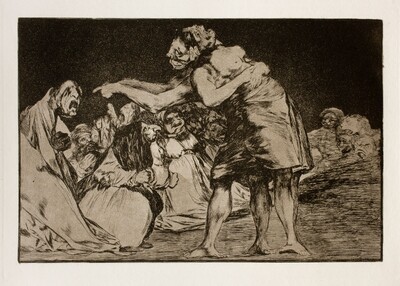- Cronología
- 1815 - 1819
- Ubicación
- The Prado National Museum. Madrid, Madrid, Spain
- Dimensiones
- 243 x 325 mm
- Técnica y soporte
- Reconocimiento de la autoría de Goya
- Documented work
- Titular
- El Prado National Museum
- Ficha: realización/revisión
- 21 Aug 2021 / 13 Apr 2023
- Inventario
- D4377
8 (in composite pencil, bottom left)
195 [inscribed in oval] (in pencil, reverse)
"n [or] engraved" [Under sticker] (reverse, upper left)
"No. 10" [On sticker] (reverse, upper centre)
MP Inventory DRAWINGS No. 195 (stamped, reverse, upper right-hand corner)
Watermark: "MANUEL SERRA" (right half)
The drawing was inherited in 1828 by Javier Goya, the painter's son, and in 1854 by Mariano Goya y Goicoechea, the artist's grandson. It was subsequently owned by Valentín Carderera (ca. 1861) and Mariano Carderera (ca. 1880). In 1886 it was acquired from Mariano Carderera by the Directorate General of Public Instruction and was assigned to the Prado Museum, where it entered on 12 November 1886.
It is not certain that this drawing was preparatory for Messy folly, although it is possible. It seems to have been reported on copper and passed through the press, because of the black spots that appear on the lower part of the sheet, so it must be related to an engraving, although it has not been preserved.
The connection with Messy folly comes from the huge hooded central figure, covered in a kind of monastic habit, pointing an accusing finger at a figure. Behind him is a large depersonified crowd. This giant would embody the Church and through him Goya would exemplify the Church's intimidating methods over the masses, as his large size in relation to the figure he is pointing at is remarkable. The Aragonese artist disguised this attack on the Church in the passage to the print, transforming the monk into a monster who does not seem to connect with the clergy. In this process he includes in his attack the whole of complicit and condescending society, which allows itself to be manipulated by the ecclesiastical powers and by all that is related to evil.
Pierre Gassier thinks that this drawing has no connection with Messy folly, being little more than an accumulation of ideas independent of each other. He sees no connection between the giant and the crowd on the left, which could be part of another theme sketched on the free part of the sheet. This idea would be supported by the bird that appears when the sheet of paper is turned over, so that the different elements would have been produced at different times and without any connection between them.
-
Los dibujos de GoyaMuseo Provincial de ZaragozaZaragoza1978exhibition organized by Museo Provincial de Zaragoza, Ministerio de Cultura and Ayuntamiento de Zaragoza, exhibition guide written by Miguel Beltrán Lloris and Micaela Pérez Sáenz. October 1978cat. 125
-
Madrid1999
-
GoyaGalleria Nazionale d’Arte Antica di Palazzo BarberiniRoma2000consultant editors Lorenza Mochi Onori and Claudio Strinati. From March 18th to June 18th 2000
-
París2001
-
Los dibujos de Goya, 2 vols.MadridAmigos del Museo del Prado1954cat. 391
-
Vie et ouvre de Francisco de GoyaParísOffice du livre1970p. 325, cat. 1581
-
Dibujos de Goya, 2 volsBarcelonaNoguer1975pp. 460-461, cat. 304
-
Roma Edizioni de Luca2000pp. 124-125, cat. 39

